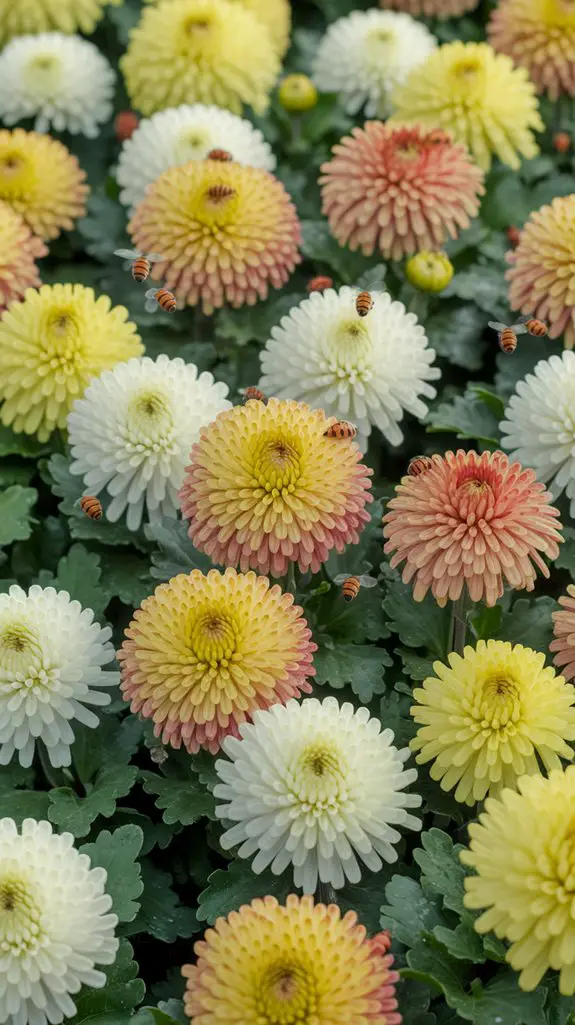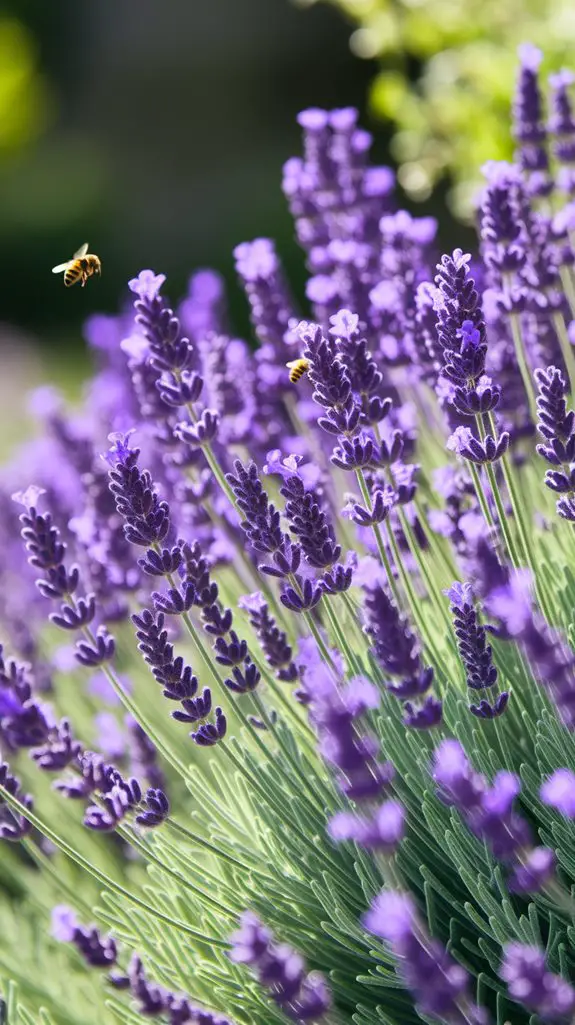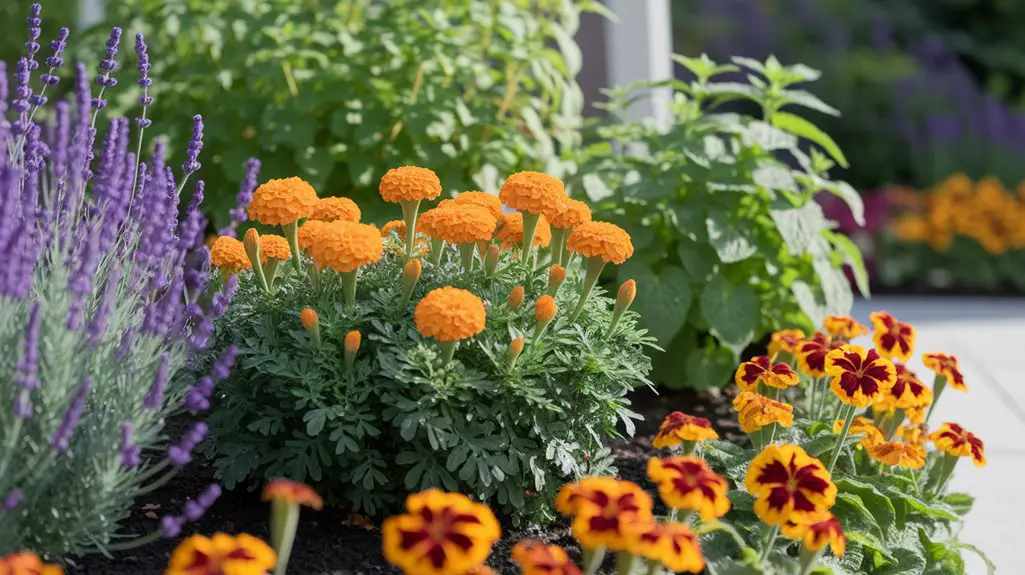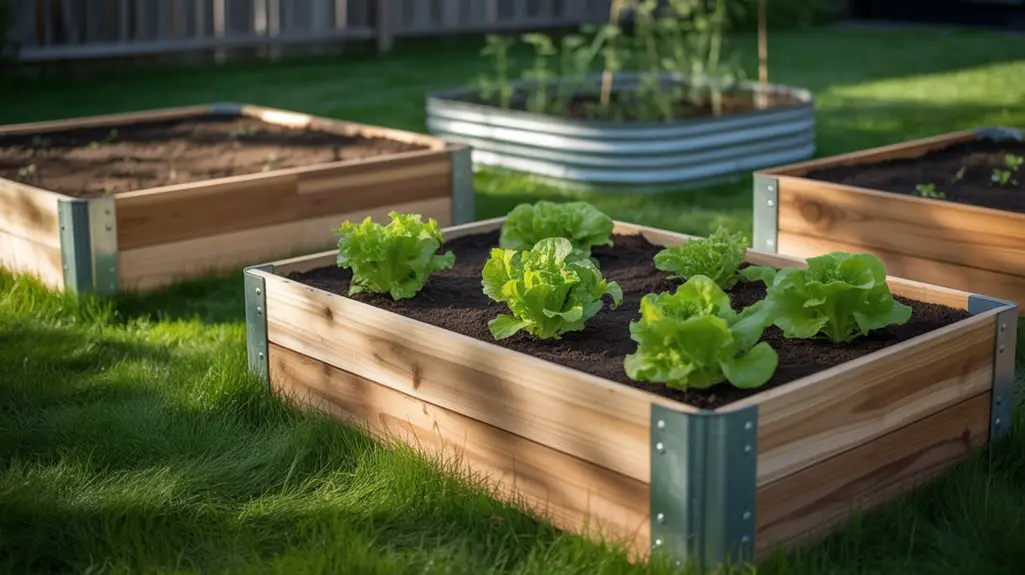You’ll find nature’s own pest management system right in your flower beds. Strategic cultivation of certain botanical species can establish a protective barrier through their biochemical defenses. Marigolds release thiophenes that penetrate soil and eliminate nematodes, while chrysanthemums contain natural pyrethrins that disrupt insect neurological function. These defensive compounds aren’t just effective—they’re sustainable alternatives to synthetic pesticides. The following selections represent nature’s most efficient pest deterrents for your garden ecosystem.
Marigolds: Nature’s Pest Control Warriors
While commonly admired for their vibrant orange and yellow blooms, Tagetes species—commonly known as marigolds—function as exceptional biological pest deterrents in integrated garden management systems. Their roots exude thiophenes, biochemical compounds that repel nematodes and soil-borne pathogens.
You’ll find marigolds particularly effective against whiteflies, aphids, and mosquitoes due to their pungent foliar terpenes. For ideal pest management, plant T. patula (French marigold) or T. erecta (African marigold) as companion flora alongside Solanum and Brassica cultivars.
Space your marigolds 20-30 cm apart in full sun locations with well-draining soil. Their allelopathic properties remain active for approximately 50 days after establishment. Additionally, marigolds can attract beneficial insects, such as pollinators and predators, which further enhance pest control in your garden.
Deadhead spent blooms regularly to extend their deterrent efficacy through continuous flowering cycles.
Chrysanthemums and Their Powerful Pyrethrins

Chrysanthemums (Chrysanthemum cinerariifolium and C. coccineum) contain six essential pyrethrin esters that function as powerful neurotoxins to arthropod pests while remaining relatively benign to mammals.
These compounds disrupt insects’ nervous systems on contact, providing immediate and residual protection for your garden ecosystem.
You’ll gain maximum pyrethrin concentration by planting:
- C. cinerariifolium in well-drained, slightly alkaline soil (pH 6.5-7.0)
- Full sun exposure (minimum 6 hours daily) to enhance essential oil production
- Spacing of 30-45cm between specimens to promote adequate air circulation
- Harvest of flowers at peak bloom when pyrethrin content reaches peak levels
- Strategic placement near susceptible crops like brassicas and nightshades
The pyrethrin compounds degrade rapidly in sunlight, making them environmentally compatible while delivering effective control of aphids, leafhoppers, spider mites, and numerous lepidopteran larvae.
Lavender: Beautiful Blooms That Bugs Hate

Lavender (Lavandula spp.) produces monoterpenoid compounds, particularly linalool and linalyl acetate, that function as potent insect repellents within your integrated pest management system.
These biochemicals effectively deter aphids, whiteflies, and various Lepidoptera larvae while simultaneously attracting beneficial pollinators. Additionally, lavender is known for its ability to repel a variety of common garden pests, making it a valuable addition to any backyard.
For maximum efficacy, plant L. angustifolia or L. x intermedia in full sun locations with well-drained, alkaline soil (pH 6.5-8.0).
Space plants 24-36 inches apart to guarantee adequate air circulation, preventing fungal pathogens.
Prune annually after flowering to maintain compact growth and sustained terpene production.
You’ll achieve peak pest control by strategically positioning lavender near vulnerable crops or entranceways.
The volatile oils reach peak concentration during flowering, so time your harvest accordingly.
Dried lavender retains its repellent properties, making it suitable for sachets to protect stored produce.
Petunias: Colorful Deterrents for Aphids and Beetles
Petunias (Petunia × hybrida) synthesize secondary metabolites including phenylpropanoids and alkaloids that function as effective feeding deterrents against multiple pest species.
These annual ornamentals provide dual aesthetic and protective benefits in integrated pest management systems.
You’ll find petunias particularly efficacious against:
- Aphids (Aphididae) – repelled by petunia’s volatile compounds
- Japanese beetles (Popillia japonica) – deterred by alkaloid content
- Leafhoppers (Cicadellidae) – avoid plants due to trichome structures
- Asparagus beetles (Crioceris spp.) – repelled by specific terpenoids
- Tomato hornworms (Manduca quinquemaculata) – deterred when intercropped
Optimal cultivation requires well-draining soil with pH 6.0-7.0 and full sun exposure. Additionally, incorporating wildlife-friendly practices can further enhance the ecological balance in your garden.
Space plants 30-45cm apart to maximize airflow, reducing fungal pathogen susceptibility.
Deadhead spent blooms to extend flowering period and maintain bioactive compound production throughout the growing season.
Nasturtiums as Sacrificial Trap Plants
Unlike the repellent action of petunias, nasturtiums (Tropaeolum majus) employ a fundamentally different pest management strategy through their function as sacrificial trap plants. They attract aphids and certain Lepidoptera species away from your primary crops by offering preferential oviposition sites.
You’ll find nasturtiums particularly effective when planted as border rows around vegetable gardens. The plants’ glucosinolate content serves as a powerful attractant for cabbage white butterflies (Pieris spp.) and black bean aphids (Aphis fabae).
When these pests colonize the nasturtiums, you’re effectively protecting adjacent brassicas and legumes. For maximum efficacy, establish nasturtiums 2-3 weeks before your primary crops.
Monitor infestation levels regularly and remove heavily infested specimens before pests can migrate. This trap cropping technique provides sustainable integrated pest management without synthetic chemical interventions.
Geraniums: The Mosquito and Leafhoppers’ Enemy
- Plant *P. citrosum* varieties near patios or windows for maximum mosquito deterrence.
- Interplant P. graveolens between susceptible crops to repel leafhoppers.
- Cultivate in well-draining soil with pH 6.0-6.5 for ideal essential oil production.
- Harvest leaf material during morning hours when volatile compounds concentrate.
- Propagate via stem cuttings dipped in rooting hormone for genetic consistency.
These geraniums thrive in USDA zones 9-10 as perennials but can be grown as annuals or container specimens in colder regions. Additionally, natural pest solutions can enhance the effectiveness of these plants in your garden.
Mint Family Flowers for Multi-Pest Protection
While many ornamental plants offer limited pest control benefits, members of the Lamiaceae (mint) family stand out for their exceptional versatility in deterring multiple pest species simultaneously.
You’ll find that established specimens of Monarda (bee balm), Nepeta (catmint), and Salvia (sage) emit volatile terpenes that repel aphids, spider mites, and whiteflies.
For maximum efficacy, position these aromatic perennials strategically throughout your garden beds. Nepeta’s nepetalactone compounds specifically deter mosquitoes and cockroaches, while Salvia’s pungent oils repel cabbage moths and carrot flies.
You’ll achieve ideal pest management by planting in clusters rather than as isolated specimens, creating concentrated zones of bioactive compounds. Additionally, incorporating these plants fosters a healthier ecosystem that supports natural pest control methods and increases biodiversity in your garden.
Unlike chemical pesticides, these Lamiaceae members integrate seamlessly into edible landscapes without contamination concerns, while simultaneously attracting beneficial pollinators.
Sunflowers: Attract Beneficial Insects, Repel Pests
Sunflowers (Helianthus annuus) serve as multifunctional pest management allies in diverse garden ecosystems. These towering compositae family members function as trap plants while simultaneously attracting beneficial predatory insects that consume common garden pests.
- Pirate bugs (Orius spp.) colonize sunflower heads, preying on thrips and aphid populations.
- Parasitoid wasps utilize sunflower nectar as energy source while hunting caterpillars.
- Planted as border crops, sunflowers intercept cucumber beetles before reaching vulnerable cucurbits.
- Sunflower pollen provides essential nutrition for ladybird beetles (Coccinellidae).
- Stem tissue serves as habitat for predatory spiders that control multiple pest species.
You’ll find ideal pest management results by planting multiple sunflower varieties with staggered blooming periods. Additionally, including organic pest control methods in your garden strategy can enhance the effectiveness of sunflowers in managing pest populations.
Position sunflowers strategically along garden perimeters where they’ll function as both sentinel plants and beneficial insect reservoirs throughout the growing season.
Companion Planting Strategies With Pest-Repelling Flowers
Strategic companion planting with pest-repelling flowers forms the cornerstone of integrated ecological pest management systems. You’ll find that interplanting specific floral species creates biological barriers that disrupt pest life cycles while enhancing crop vigor.
| Flower Species | Target Pests | Companion Crops |
|---|---|---|
| Tagetes spp. | Nematodes | Solanaceae |
| Tropaeolum majus | Aphids, Whiteflies | Brassicaceae |
| Calendula officinalis | Thrips, Asparagus beetles | Allium spp. |
| Tanacetum cinerariifolium | Lepidopteran larvae | Cucurbitaceae |
| Nepeta cataria | Aphids, Squash bugs | Leguminosae |
Implement polyculture planting by interspersing aromatic species containing volatile terpenes throughout your cultivation area. Establish perennial pest-repellent borders comprising Lavandula, Rosmarinus, and Salvia to create permanent insectary habitats. This approach leverages allelopathic compounds and olfactory confusion to maintain phytophagous insect populations below economic threshold levels. Additionally, incorporating eco-friendly practices in your gardening not only promotes biodiversity but also fosters a healthier ecosystem.
Maintaining Your Natural Pest Barrier Year-Round
To maintain efficacious pest-deterrent properties throughout all seasonal fluctuations, your floral defense system requires systematic succession planning and phenological synchronization. Different pest species emerge at variable temporal intervals, necessitating continuous protective botanical presence.
- Implement staggered planting schedules of Tagetes spp. (marigolds) at 3-week intervals for sustained thiopene release.
- Cultivate cold-hardy Chrysanthemum cinerariaefolium (pyrethrum) for winter pest management when temperatures exceed 5°C.
- Establish evergreen Rosmarinus officinalis (rosemary) as perimeter sentinel plants for consistent terpenoid emission.
- Integrate quick-blooming Tropaeolum majus (nasturtium) for rapid response to sudden aphid population increases.
- Maintain Calendula officinalis seedlings under cold frames for early spring transplantation when Hemiptera species emerge.
Additionally, employing garlic spray can enhance your natural pest control efforts by utilizing its strong odor to repel unwanted insects. This perpetual defense strategy guarantees year-round bioprotection through phytochemical diversity and temporal distribution of allelopathic compounds across your cultivation area.
Conclusion
As you curate your garden’s defensive perimeter, you’re not just planting flowers—you’re establishing ecological sentinels that stand vigilant while you sleep. Like ancient city walls protecting precious resources within, your integrated floral defense system employs phytochemical warfare through terpenes, flavonoids, and alkaloids. Nature’s evolutionary arms race becomes your cultivation strategy, creating a self-regulating biome where Tagetes, Lavandula, and Tropaeolum species collaborate in maintaining homeostasis without synthetic interventions.




